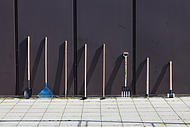The Garden
The Garden

We have been given 1300m2 on the ETH campus, a space marked off by a simple fence. We are the pioneers of this new garden. We will dig holes, realise the weight of soil and the speed at which grass grows. It will change your relationship to nature.

This garden is a new model of learning, one that does not have the parameters of a semester, school year or degree course. Instead, like a science laboratory, it is a framework for innovation over time. We will consider the consequences of our choices in one semester, one year, five years, twenty-five years and fifty years. We will learn from growth and decay, the spectrum of natural processes and the patina of time. Gardens thrive while architecture ages: our site will be an opportunity to explore this reality first-hand.
Our project will be a finished piece in itself. But it will also be the foundations of the next. The process of adaptation lies at the heart of architecture and at the core of this design studio. The garden is a room from which nothing ever leaves and where everything can be boiled, burnt, eaten and reused. Unlike previous group projects in the studio, the garden is not a pavilion that will be dismantled at the end of the semester. We and those that come after us will need to care for and nurture it. We will learn from success, failure and surprises. As the garden becomes more established fencing may become obsolete, trees might be coppiced to make social spaces, furniture might be burned to fertilise the soil. It will be a form of layered bricolage that encourages you to engage with the social, historical and scientific attributes of nature.
The design and development of the garden is broken down into six tasks that unfold simultaneously. We are asked to analyse, structure, plant, populate, build and maintain. As the first students to enter the garden we will be particularly responsible for analysing the soil conditions and preparing the ground. Soil is not a line at the bottom of the page, it is a living substance: it can be healthy; it can be unhealthy; it can be suitable for very different things.

Like with any true experiment, analysis and data collection lies at the heart of its success. Students will conduct an ongoing survey of the garden that highlights the layering and reconfiguring of each semester cycle. One year it may be a medicinal garden, another year it may be a bird sanctuary or a lake. History is an indelible part of the garden but can be peeled away in survey form.


